Job’s tears
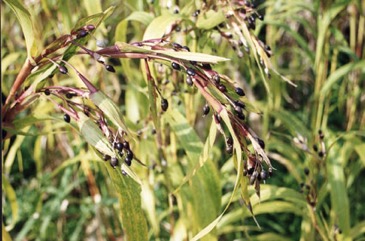
A tropical and subtropical plant. It grows wild and semi-cultivated in many areas of Papua New Guinea. It is well suited to grow in swampy places. It grows in wetlands. It grows up to 2000 m altitude in the tropics. It needs a temperature above 13-16°C. It suits hardiness zones 9-11. In Yunnan.
Also known as:
Adlay millet, Adlay, Anjalai, Bbirkaulo, Bilen, Bonco, Butsu wasil, Chuan gu, Deuy, Duei, Gurgur, Holo, Hongo, Isangu, Jali, Jali-jali, Jangali zuvaai, Jargadi, Jelai pulut, Jelai, Joli, Juzudama, Ka-leik, Kalein, Kasaiya, Kattu kundumani, Kola, Kolgowa, Kyeik, Miimtang, Mwahile hile, Netpavalam, Nongo, Oshiito, Pikopiko, Pooshakkal, Ranmakkai, Sanasana, Sankru, Senjelai, Shankru, Sku'ey, Sohriu, Tear-grass, Tiaku, Trigo tropical, Tumdak, Wasil, Yi yi, Yusari
Synonyms
- Coix agrestis Lour.
- Coix arundinacea Lam.
- Coix lachryma Linn.
Edible Portion
- Seeds, Cereal
Where does Job’s tears grow?
Found in: Africa, American Samoa, Argentina, Asia, Australia, Bhutan, Brazil, Cambodia, Cameroon, Central Africa, Central America, China, Congo DR, Côte d'Ivoire, Cuba, Dominican Republic, East Africa, East Timor, Easter Island, Ecuador, Fiji, Ghana, Guam, Guiana, Guianas, Guinea, Guinée, Guinea-Bissau, Guyana, Haiti, Himalayas, India, Indochina, Indonesia, Ivory Coast, Japan, Korea, Laos, Liberia, Madagascar, Malaysia, Maldives, Mariana Islands, Marquesas, Mozambique, Myanmar, Nepal, Nigeria, Northeastern India, Pacific, Pakistan, Papua New Guinea, PNG, Paraguay, Peru, Philippines, Sao Tome and Principe, SE Asia, Senegal, Sierra Leone, Singapore, Slovenia, South Africa, Southern Africa, South America, Sri Lanka, St. Kitts and Nevis, Suriname, Taiwan, Thailand, Timor-Leste, Tonga, Trinidad, Vanuatu, Venezuela, Vietnam, West Africa, West Indies
Notes: Chemical composition (grams /100g): Protein = 18.81g. Fat = 6.2g. Carbohydrate (soluble) = 59.55g. Fibre = 1.28g. Ash = 3.4g. Water = 10.74g. Calories = 378.
Status: Common in most areas of Papua New Guinea but rarely eaten. It is eaten often in some places e.g. Mendi Valley. Similarly in many tropical countries, the thin shelled form is used as food. It is a cultivated food plant.
Growing Job’s tears
Cultivation: Plants are grown by seed. It grows wild in many swampy places. Seed are sown 5 cm deep. Plants are spaced at 40-60 cm.
Edible Uses: The seeds are eaten raw. They can be cooked like rice. The seeds can be crushed to produce a cereal flour. This is best mixed with wheat flour to make a lighter but tasty flour. The seeds are used in soups, porridges, drinks or pastries. It is used for brewing beer. The parched seeds are used for a tea-like drink.
Production: Seeds are ready to harvest about 5 months after sowing. On poor soils in dry conditions, hollow fruits may be produced. The tough seed shell has to be broken.
Nutrition Info
per 100g edible portion| Edible Part | Energy (kcal) | Protein (g) | Iron (mg) | Vitamin A (ug) | Vitamin c (mg) | Zinc (mg) | % Water |
|---|---|---|---|---|---|---|---|
| Seed | 306 | 12 | 0.7 | 0 | 0 | - | 15 |
Job’s tears Photos

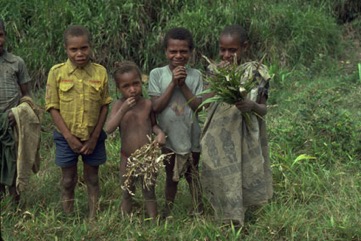
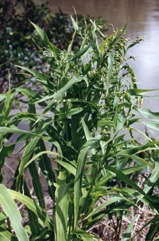
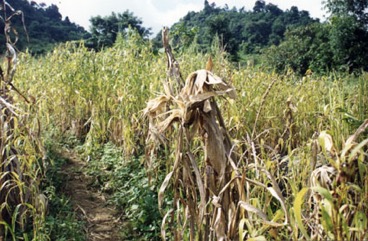
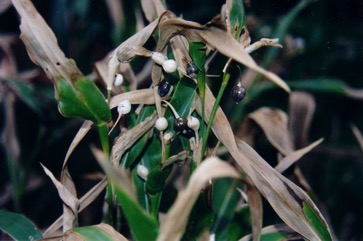
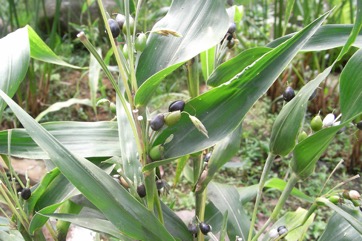
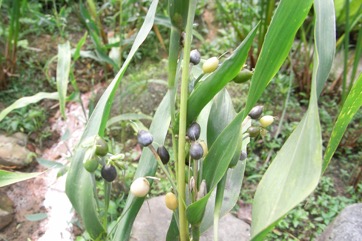
References
References for Job's tears Coix lacryma-jobi.
Altschul, S.V.R., 1973, Drugs and Foods from Little-known Plants. Notes in Harvard University Herbaria. Harvard Univ. Press. Massachusetts. no. 10
Ambasta, S.P. (Ed.), 2000, The Useful Plants of India. CSIR India. p 135
Anderson, E. F., 1993, Plants and people of the Golden Triangle. Dioscorides Press. p 207
Arora, R. K., 2014, Diversity in Underutilized Plant Species - An Asia-Pacific Perspective. Bioversity International. p 102
Bennett, B. C., 1990, Useful Plants of Amazonian Ecuador. US Agency for International Development. Fifth Progress Report. New York Botanical Gardens. p 39
Borrell, O.W., 1989, An Annotated Checklist of the Flora of Kairiru Island, New Guinea. Marcellin College, Victoria Australia. p 22
Bremness, L., 1994, Herbs. Collins Eyewitness Handbooks. Harper Collins. p 242
Brickell, C. (Ed.), 1999, The Royal Horticultural Society A-Z Encyclopedia of Garden Plants. Convent Garden Books. p 286
Brown, D., 2002, The Royal Horticultural Society encyclopedia of Herbs and their uses. DK Books. p 175
Brown, W.H., 1920, Wild Food Plants of the Philippines. Bureau of Forestry Bulletin No. 21 Manila. p 26
Burkill, H. M., 1985, The useful plants of west tropical Africa, Vol. 2. Kew.
Burkill, I.H., 1966, A Dictionary of the Economic Products of the Malay Peninsula. Ministry of Agriculture and Cooperatives, Kuala Lumpur, Malaysia. Vol 1 (A-H) p 637
Cabalion, P. and Morat, P., 1983, Introduction le vegetation, la flore et aux noms vernaculaires de l'ile de Pentcoste (Vanuatu), In: Journal d'agriculture traditionnelle et de botanique appliquee JATBA Vol. 30, 3-4
Cribb, A.B. & J.W., 1976, Wild Food in Australia, Fontana. p 101
Dobriyal, M. J. R. & Dobriyal, R., 2014, Non Wood Forest Produce an Option for Ethnic Food and Nutritional Security in India. Int. J. of Usuf. Mngt. 15(1):17-37
Ekman Herbarium records Haiti
Ethnobotany of Karbis. Chapter 4 in p 82
Facciola, S., 1998, Cornucopia 2: a Source Book of Edible Plants. Kampong Publications, p 174
Flora of Pakistan. www.eFloras.org
Fox, F. W. & Young, M. E. N., 1982, Food from the Veld. Delta Books. p 298
Franklin, J., Keppel, G., & Whistler, W., 2008, The vegetation and flora of Lakeba, Nayau and Aiwa Islands, Central Lau Group, Fiji. Micronesica 40(1/2): 169–225, 2008
French, B.R., 1986, Food Plants of Papua New Guinea, A Compendium. Asia Pacific Science Foundation p 137
Gangwar, A. K. & Ramakrishnan, P. S., 1990, Ethnobotanical Notes on Some Tribes of Arunachal Pradesh, Northeastern India. Economic Botany, Vol. 44, No. 1 pp. 94-105
Guite, C., 2016, A study of wild edible plants associated with the Paite tribe of Manipur, India, International Journal of Current Research. Vol. 8, Issue, 11, pp. 40927-40932
Hani Medicine of Xishuangbanna, 1999, p 459
Hedrick, U.P., 1919, (Ed.), Sturtevant's edible plants of the world. p 210
Hibbert, M., 2002, The Aussie Plant Finder 2002, Florilegium. p 71
Hu, Shiu-ying, 2005, Food Plants of China. The Chinese University Press. p 287
Hwang, HS, et al, 2014, Distribution characteristics of plant in the Ungseokbong Mountain, Gyeongsangnam-do, Korea. Journal of Asia-Pacific Biodiversity. 7(2014) e164-e178
Jacquat, C., 1990, Plants from the Markets of Thailand. D.K. Book House p 120
Jansen, P.C.M., 2006. Coix lacryma-jobi L. [Internet] Record from Protabase. Brink, M. & Belay, G. (Editors). PROTA (Plant Resources of Tropical Africa), Wageningen, Netherlands. < http://database.prota.org/search.htm>. Accessed 15 October 2009.
Jardin, C., 1970, List of Foods Used In Africa, FAO Nutrition Information Document Series No 2. p 2
Joyal, E., 1987, Ethnobotanical Field Notes from Ecuador: Camp, Prieto, Jorgensen, and Giler. Economic Botany 41(2): 163-189
Kiple, K.F. & Ornelas, K.C., (eds), 2000, The Cambridge World History of Food. CUP p 117, 1793
Kuo, W. H. J., (Ed.) Taiwan's Ethnobotanical Database (1900-2000), http://tk.agron.ntu.edu.tw/ethnobot/DB1.htm
Lazarides, M. & Hince, B., 1993, Handbook of Economic Plants of Australia, CSIRO. p 63
Lokho, K. & Narasimhan, D., 2013, Ethnobotany of Mao-Naga Tribe of Manipur, India. Pleione 7(2): 314-324
Macmillan, H.F. (Revised Barlow, H.S., et al), 1991, Tropical Planting and Gardening. Sixth edition. Malayan Nature Society. Kuala Lumpur. p 351
Manandhar, N.P., 2002, Plants and People of Nepal. Timber Press. Portland, Oregon. p 164
McMakin, P.D., 2000, Flowering Plants of Thailand. A Field Guide. White Lotus. p 93
Miguel, E., et al, 1989, A checklist of the cultivated plants of Cuba. Kulturpflanze 37. 1989, 211-357
Omawale, 1973, Guyana's edible plants. Guyana University, Georgetown p 96
Paczkowska, G. & Chapman, A.R., 2000, The Western Australian Flora. A Descriptive Catalogue. Western Australian Herbarium. p 100
PATON & DUNLOP,
Peekel, P.G., 1984, (Translation E.E.Henty), Flora of the Bismarck Archipelago for Naturalists, Division of Botany, Lae, PNG. p 44, 45
Phon, P., 2000, Plants used in Cambodia. © Pauline Dy Phon, Phnom Penh, Cambodia. p 167
Plants for a Future database, The Field, Penpol, Lostwithiel, Cornwall, PL22 0NG, UK. http://www.scs.leeds.ac.uk/pfaf/
Plants of Haiti Smithsonian Institute http://botany.si.edu/antilles/West Indies
Powell, J.M., Ethnobotany. In Paijmans, K., 1976, New Guinea Vegetation. Australian National University Press. p 109
PROSEA (Plant Resources of South East Asia) handbook, Volume
Purseglove, J.W., 1972, Tropical Crops. Monocotyledons. Longmans p 134
Ramachandran,V. S., & Udhayavani, C., 2013, Knowledge and uses of wild edible plants by Paniyas and Kurumbas of Western Nilgiris, Tamil Nadu. Indian Journal of Natural Products and Resources. 4(4) December 2013, pp 412-418
Recher, P, 2001, Fruit Spirit Botanical Gardens Plant Index. www.nrg.com.au/~recher/ seedlist.html p 1
Reid, L. A. & Madulid, D., 1972, Some comments on Bontoc Ethnobotany. Philippine Journal of Linguistics
Reis, S. V. and Lipp, F. L., 1982, New Plant Sources for Drugs and Foods from the New York Botanical Garden herbarium. Harvard. p 10
Romanowski, N., 2007, Edible Water Gardens. Hyland House. p 85
Ruiters-Welcome, A. K., 2019, Food plants of southern Africa. Ph.D. thesis. Univ. of Johannesburg p 87
Singh, V. and Singh, P., 1981, Edible Wild Plants of Eastern Rajasthan. J. Econ. Tax. Bot. Vol 2 pp 197-207
Smith, P.M., 1979, Adlay, Job’s tears, in Simmonds, N.W., (ed), Crop Plant Evolution. Longmans. London. p 307
Sp. pl. 2:972. 1753
Sujanapal, P., & Sankaran, K. V., 2016, Common Plants of Maldives. FAO & Kerala FRI, p 93
Sukarya, D. G., (Ed.) 2013, 3,500 Plant Species of the Botanic Gardens of Indonesia. LIPI p 1090
Swapna, M. M. et al, 2011, A review on the medicinal and edible aspects of aquatic and wetland plants of India. J. Med. Plants Res. 5 (33) pp. 7163-7176
Terashima, H., et al, 1992, Ethnobotany of the Lega in the Tropical Rainforest of Eastern Zaire (Congo): Part Two, Zone de Walikale, African Study Monographs, Suppl. 19:1-60
Teron, R. & Borthakur, S. K., 2016, Edible Medicines: An Exploration of Medicinal Plants in Dietary Practices of Karbi Tribal Population of Assam, Northeast India. In Mondal, N. & Sen, J.(Ed.) Nutrition and Health among tribal populations of India. p 154
van Wyk, B., 2005, Food Plants of the World. An illustrated guide. Timber press. p 148
van Wyk, Be, & Gericke, N., 2007, People's plants. A Guide to Useful Plants of Southern Africa. Briza. p 9
Wiriadinata, H., 1995, Ethnobotany of Economic Plants in the Baliem Valley, Jayawijaya, Irian Jaya, Indonesian Institute of Science, Bogor, Indonesia
World Checklist of Useful Plant Species 2020. Royal Botanic Gardens, Kew
www.ethnobiomed.com
Zhang, Y., et al, 2014, Diversity of wetland plants used traditionally in China: a literature review. Journal of Ethnobiology and Ethnomedicine. 10:72
Zizka, G., 1991, Flowering Plants of Easter Island. Palmarum Hortus Francofurtensis